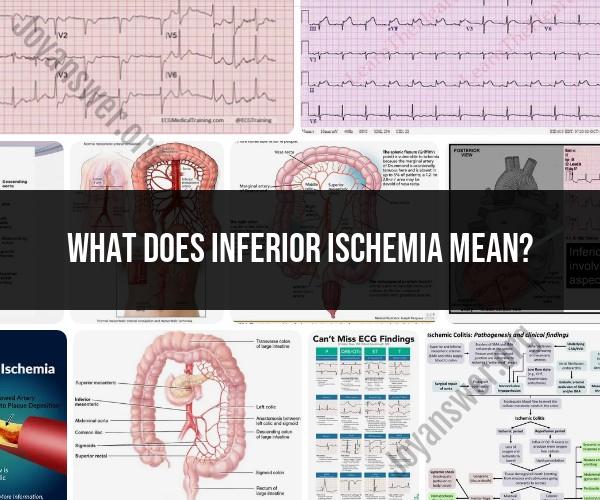What does inferior ischemia mean?
"Inferior ischemia" typically refers to a condition in which there is reduced blood flow or inadequate oxygen supply to the inferior part of the heart, specifically the inferior wall of the left ventricle. This can occur due to various factors and is often associated with coronary artery disease (CAD) or other cardiovascular conditions. Here's a breakdown of the key components:
Inferior: "Inferior" in this context refers to the lower part of the heart. The heart is divided into different regions, including the anterior (front), lateral (side), and inferior (bottom) walls.
Ischemia: Ischemia is a medical term that describes a lack of blood flow and oxygen to tissues or organs. When the heart muscle (myocardium) doesn't receive an adequate supply of blood and oxygen, it can lead to ischemia, which can cause chest pain or discomfort, often referred to as angina.
In the case of inferior ischemia, the inferior part of the heart is not receiving sufficient blood flow or oxygen, which can result in reduced heart function and the potential for chest pain or other symptoms. Inferior ischemia is typically evaluated through various diagnostic tests, such as electrocardiograms (ECG or EKG), stress tests, and imaging studies like echocardiograms or coronary angiography.
The underlying cause of inferior ischemia is often related to coronary artery disease, where one or more of the coronary arteries that supply blood to the heart become narrowed or blocked by atherosclerotic plaque. This can restrict blood flow to various parts of the heart, including the inferior region.
The management of inferior ischemia typically involves addressing the underlying causes, such as controlling risk factors (e.g., high blood pressure, high cholesterol, smoking), lifestyle modifications (e.g., diet and exercise), medications (e.g., antiplatelet drugs, beta-blockers, nitroglycerin), and, in some cases, interventional procedures like angioplasty and stent placement or coronary artery bypass surgery to improve blood flow to the affected area of the heart. Treatment plans are tailored to each individual's specific condition and medical history. If you or someone you know is experiencing symptoms suggestive of inferior ischemia, it's essential to seek prompt medical evaluation and care to prevent potential complications and improve heart health.
Decoding Inferior Ischemia: What It Means for Your Health
Inferior ischemia is a condition in which the blood flow to the inferior wall of the heart is reduced. The inferior wall is the bottom part of the heart. Inferior ischemia can be caused by a number of factors, including:
- Atherosclerosis: Atherosclerosis is the buildup of plaque in the arteries. Plaque can narrow the arteries and restrict blood flow.
- Blood clots: Blood clots can block the arteries and prevent blood from flowing to the heart.
- Spasm: A spasm is a sudden contraction of the coronary arteries. This can reduce blood flow to the heart.
Inferior ischemia can lead to a number of health problems, including:
- Angina pectoris: Angina pectoris is chest pain that occurs when the heart is not getting enough blood.
- Myocardial infarction (heart attack): A heart attack occurs when the blood supply to a part of the heart is completely blocked. This can damage or destroy the heart muscle.
- Heart failure: Heart failure occurs when the heart is not able to pump blood as effectively as it should.
The Heart and Inferior Ischemia: A Closer Look at the Condition
Inferior ischemia can be diagnosed using a number of tests, including:
- Electrocardiogram (EKG): An EKG measures the electrical activity of the heart. It can be used to detect changes in the heart's rhythm and to look for signs of heart damage.
- Stress test: A stress test is used to see how the heart performs when it is under stress. This can be done by exercising on a treadmill or by using medication to increase the heart rate.
- Echocardiogram: An echocardiogram uses sound waves to create an image of the heart. It can be used to assess the heart's function and to look for signs of heart damage.
Health Implications: Understanding Inferior Ischemia
Inferior ischemia is a serious condition that can lead to a number of health problems. If you have any symptoms of inferior ischemia, it is important to see a doctor right away.
Treatment for inferior ischemia may include:
- Lifestyle changes: Quitting smoking, eating a healthy diet, and exercising regularly can help to reduce the risk of heart problems.
- Medications: Medications, such as blood thinners, cholesterol-lowering medications, and beta-blockers, can help to improve blood flow and reduce the risk of heart problems.
- Angioplasty and stenting: Angioplasty and stenting are procedures that can be used to open up blocked arteries.
- Bypass surgery: Bypass surgery is a procedure that creates a new path for blood to flow around a blocked artery.
Early diagnosis and treatment of inferior ischemia are essential to prevent complications and improve heart health.
If you have any concerns about your heart health, it is important to talk to your doctor.













